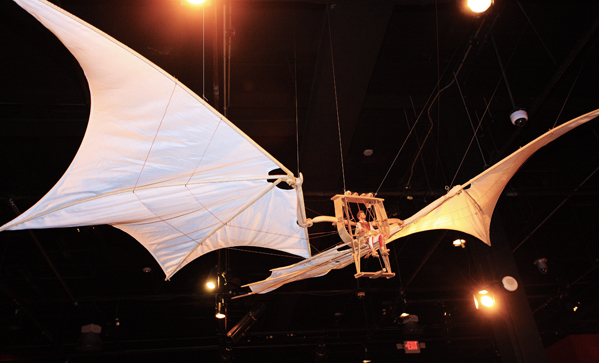Skill-testing question: Who invented the airplane? If you are thinking the Wright brothers, you are wrong. At least partially.
Bringing new meaning to “ahead of his time,” Leonardo da Vinci conceptualized the airplane in his Codex of Flight, where he studied the flight of birds and used his findings to design his flying machine, The Great Kite (created before the great-great-grandparents of the Wright Brothers were even born). Although he never succeeded in building a working flying machine, his findings are still used in principles of flight today. Known mainly for his famous paintings Mona Lisa and The Last Supper, Leonardo da Vinci’s resume goes far beyond oil and canvas.
Until March 2012, Torontonians will have the chance to play, interact with, read and observe some of the world’s most prolific inventions, ideas, and artistic masterpieces, digitally and physically recreated at Leonardo da Vinci’s Workshop at the Ontario Science Centre. Through his notebooks (codices), Codex Atlanticus, Codex of Flight, and Manuscript B, researchers have been able to unravel the inner workings of one of the greatest thinkers in history.
Leonardo3 (L3), a research centre based in Milan dedicated to studying and interpreting cultural heritage to make it available to the public, has used cutting-edge technology (including 3-dimensional imagery and animations), touch screens and interactive digital activities to unleash Da Vinci’s genius on the world.
“This exhibition demonstrates the full scope of Leonardo’s remarkable genius and, most importantly, allows the public to explore his most important surviving manuscripts,” said Massimiliano Lisa, curator and CEO of Leonardo3.
Hand-built following da Vinci’s notes and diagrams, L3 has put together almost-exact replications of some of da Vinci’s most impressive works, such as the Mechanical Lion originally created to entertain the king of France, the Harpsichord-Viola, a piano/string instrument hybrid (created by Da Vinci long before the invention of the piano) and the Robot Knight.
The 3-D versions of da Vinci’s notebooks allow Science Centre patrons to zoom in, translate and get up-close and personal with some of the most important documents in history. L3 has also used its own technology, HyperView, to allow interaction with drawings and paintings including Leonardo’s famous Self-Portrait, the Mona Lisa as well as The Last Supper.
Arguably the most interesting parts of the exhibition are the displays of da Vinci’s inventions that are not commonly known to everyday people. Displayed in the exhibition on interactive touch screens are his Ideal City, a city model powered by water, the Mechanical Bat, a bat-shaped flying machine, the Multi-Cannon Gunship, a self-operated paddle boat of sorts with gears and shafts that take over to keep speed consistent, and a large collection of other strategic war-machines. Though all of Da Vinci’s studies had remained hidden for such a long period of time, his inventions and ideas were still able to advance science and technology even across the centuries.
Audiences vary in their expertise and interest: pilots, wood-workers, mechanics, art enthusiasts, historians and tech-nerds alike are lining up and learning. The exhibit is a fascinating glimpse of art, war-technology, and history. Ontario Science Centre; Exhibition runs until March 18, 2012; Tickets are $25 each, or $5 for members. 770 Don Mills Road, 416-696-1000.
——————–
Image courtesy of the Ontario Science Centre.


